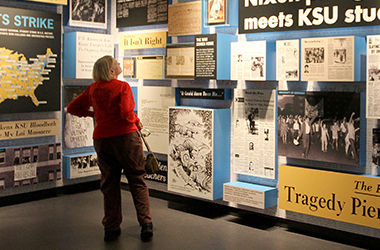Almost 45 years later, Kent State struggles to redefine its image

Kent State alumni Susan Avery of Denver, CO, tours the May 4 Visitor’s Center Wednesday, Sept. 17, 2014. Avery graduated in ’82 and said that she wanted to visit the center to pay her respects.
September 17, 2014
In response to #WeAreKentState, students and alumni all over the world showed their Kent state pride Wednesday by banding together, clad in blue and gold.
Kent State alumna Ashleigh Klinger created the hashtag as well as a Facebook event in response to Urban Outfitters selling a bloody “vintage Kent State” sweatshirt on its website earlier this week. The Facebook event, which encouraged Kent State students past and present to sport blue and gold, was an effort to rally the community together to show Urban Outfitters and the world what Kent’s true colors are, according to the Facebook event page.
Today, the university is known for its academic programs, its black squirrels and the towering chestnut trees that line front campus, but the May 4, 1970 shooting has become synonymous with Kent State. Jerry M. Lewis, sociology professor and May 4 expert, said this is because the shooting resonates with every generation.
“I don’t think (Kent State is) defined by May 4,” Lewis said. “I think it’s recognized by May 4. Kent State has lots of very strong programs – psychology is a very strong program, speech pathology is a very strong program, architecture is a very strong program. I prefer to think of it as recognized. May 4 went all over the world.”
The Urban Outfitters sweatshirt isn’t the first occasion to bring May 4 back into national conversation in recent months. News media compared the events in Ferguson, Missouri to the tragedy on May 4, as well as the shot fired on campus last spring.
Stefanie Moore, professor in the School of Journalism and Mass Communication, said that using social networking sites that allow users to add photo and video to an event increases an event’s virality.
“We’ve got alumni and students and faculty and staff all coming together with one common purpose, and throughout the nation,” Moore said. “It’s kind of fascinating to watch it unfold on Facebook.”
The trend spread quickly, with more than 2,600 users committing to wear their blue and gold. The hashtag also served as a chance for the community to remember the events of May 4, 1970, Moore said.
“Tags like this become popular because they are fueled by emotion,” she said. “It’s on the heels of what happened with Urban Outfitters. So this gives everybody at Kent State a chance to rally behind a cause.”
Lewis said he believes the story continues to resonate because college students of any generation can connect with it.
“May 4 is almost Shakespearean in terms of drama: a conflict between students and guards over the basic right of freedom of speech,” Lewis said.
Mindy Farmer, director of the May 4 Visitors Center, said that instances like the sweatshirt or the comparison to Ferguson are simply unavoidable.
“Things like that have happened in the past and are going to happen in the future,” she said. “There is no question that there will always be some people who are ignorant of the history of May 4 and misunderstand its importance.”
“But every time we have one of those incidents we can’t just sit and be upset and begrudge that these things are happening. What I would encourage is to turn that into a positive and into a teaching moment.”
The May 4 Visitors Center seeks to educate students on the factual events of May 4, Farmer said. Students are given a guided tour through three sections where they get to experience what life was like in the 1970s.
Breana Buckner, a senior public health major, said she has visited the center multiple times and each time walks away feeling more connected.
“I guess I just give those people more respect because now I feel like people our age are so unwilling to stand up for something,” said Buckner. “To see those people come together and stand together in unison for one cause kinda makes me think about how we don’t really stand up for anything anymore.”
Buckner, a Student Success Leader and former Flash Guide, said part of the Destination Kent State experience is taking a tour of the May 4 Visitors Center and visiting the memorial.
She said it’s unusual for people to tour the museum and not have at least some idea of what May 4 is, but she feels that sometimes focusing on the events of May 4 can overshadow the university’s modern-day accomplishments.
“We have so many great accomplishments, and the great accomplishments will be there and then something will just come and bring back May 4,” said Buckner. “It just continues to shadow over us, so I just feel like we’ll never lose the stigma.”
Farmer said she believes that while May 4 is certainly a part of the university’s history, it isn’t the only thing that defines the community.
“I would say it doesn’t have to be either or,” Farmer said. “It’s not only known for May 4 or we’re so much better than May 4, it can be a part of the history. It isn’t something that defines Kent State, but it is a part of Kent State.”
Undergraduate Student Body president Marvin Logan said he believes May 4, 1970 will always be important because they showed the power of students’ voices and reinforced their right to free speech.
“I think you can’t deny the legacy,” he said. “It’s something that happened, and is not only a part of Kent State’s history, but of our country’s.”
Contact Hannah Armenta at [email protected]. Emily Mills contributed to reporting.
























